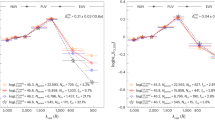Abstract
Weymann and Wilcox1 have recently claimed that there is no evidence that the true occurrence of absorption lines in quasi-stellar objects (QSOs) is a function of red-shift. Such a conclusion, if true, might be considered as evidence against the screening hypothesis discussed by several authors2–4. We feel, however, that the discussion of the data presented by Weymann and Wilcox does not warrant their strongly worded conclusion, and in fact that the data available indicate that the presence of C IV in absorption can be explained by the screening hypothesis.
This is a preview of subscription content, access via your institution
Access options
Subscribe to this journal
Receive 51 print issues and online access
$199.00 per year
only $3.90 per issue
Buy this article
- Purchase on Springer Link
- Instant access to full article PDF
Prices may be subject to local taxes which are calculated during checkout
Similar content being viewed by others
References
Weymann, R. J., and Wilcox, R. C., Nature, 219, 1031 (1968).
Bahcall, J. N., Greenstein, J. L., and Sargeant, W. L. W., Ap. J., 153, L89 (1968).
Kardashev, N., Ap. J., 150, L135 (1967).
Roeder, R. C., and Verreault, R. T., Ap. J. (in the press).
Solheim, J. E., Nature, 219, 45 (1968).
Author information
Authors and Affiliations
Rights and permissions
About this article
Cite this article
ROEDER, R., VERREAULT, R. Absorption Lines in the Spectra of Quasi-stellar Objects. Nature 220, 772–773 (1968). https://doi.org/10.1038/220772a0
Received:
Issue Date:
DOI: https://doi.org/10.1038/220772a0
Comments
By submitting a comment you agree to abide by our Terms and Community Guidelines. If you find something abusive or that does not comply with our terms or guidelines please flag it as inappropriate.



